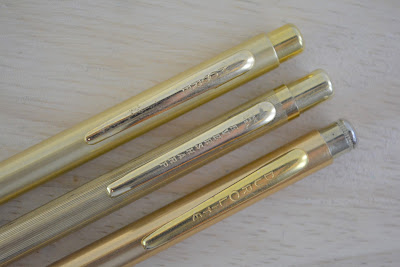This article has been edited and included in The Leadhead's Pencil Blog Volume 5; copies are available print on demand through Amazon here, and I offer an ebook version in pdf format at the Legendary Lead Company here.
If you don't want the book but you enjoy this article, please consider supporting the Blog project here.
https://leadheadpencils.blogspot.com/2018/02/my-lunchbox-special.html).
However, just because I characterized everything else that came with that special pencil as junk doesn’t mean I didn’t spend some time looking at them more closely. After all of that frog-kissing, I can assure you that 20 of the remaining 21 pencils really were junk, possessing nothing interesting for me to tell you about. However, this one did pique my curiosity:
It’s a Dur-O-Lite, with an advertising imprint for an Indiana truck garage that doesn’t help with the dating, but with something odd about it:
The cap is green, a mismatch for the nose, but since I haven’t seen that cap or clip treatment on one of these before anywhere else, I don’t know where else it might have come from. In fact, it was so out of place that it took me a few to make the connection . . . one of which is a little obvious and the other has me asking a question that contradicts a story collectors have accepted for years.
Let’s start with the obvious. The reason the clip looked out of place was because normally when I see it, it’s on the all-metal Durolite repeaters, made under Charles K. Lovejoy’s patent and originally the property of the Moore Pen Company. The mechanism was first used on cap-actuated Moore Mastercraft pencils, and then was the platform on which the Moore Fingertip pencils were based. Later, the mechanism somehow turns up on the Eversharp Envoy set:
Now . . . Moore closed in 1956, and history tells us Eversharp’s writing instruments division was sold to Parker in 1957.
Then, Lovejoy-patent pencils turn up in a Dur-O-Lite incarnation.
So there’s the obvious connection. My new Dur-O-Lite is fitted with the same clip as the Moore, Eversharp and Durolite Lovejoy-patent pencils.
But it’s the same as something else, too. That’s what has me asking some other questions:
That’s one of the later, crappy Eversharp pencils alongside the new Dur-O-Lite. With that same clip and in that exact shade of dark green:
Dur-O-Lite went on for decades after Eversharp’s takeover by Parker and subsequent demise. Identical Eversharp and Dur-O-Lite features, now found on two distinct models, have me wondering if there wasn’t something more of a relationship than a common licensing agreement with Charles Lovejoy and Moore to use one pencil mechanism. I’m wondering whether Dur-O-Lite actually purchased whatever was left of Eversharp’s pencil making operations before the sale to Parker, since these pencil lines don’t appear on Parker-marked Eversharps made after 1957. Maybe the story of Parker’s acquisition of Eversharp’s “writing instruments division” isn’t the whole story, since all Eversharp had left to sell at that point was a ballpoint and fountain pen operation.
It’s just a hypothesis at this point. But it’s worth a follow up after I do some more research.
However, just because I characterized everything else that came with that special pencil as junk doesn’t mean I didn’t spend some time looking at them more closely. After all of that frog-kissing, I can assure you that 20 of the remaining 21 pencils really were junk, possessing nothing interesting for me to tell you about. However, this one did pique my curiosity:
It’s a Dur-O-Lite, with an advertising imprint for an Indiana truck garage that doesn’t help with the dating, but with something odd about it:
The cap is green, a mismatch for the nose, but since I haven’t seen that cap or clip treatment on one of these before anywhere else, I don’t know where else it might have come from. In fact, it was so out of place that it took me a few to make the connection . . . one of which is a little obvious and the other has me asking a question that contradicts a story collectors have accepted for years.
Let’s start with the obvious. The reason the clip looked out of place was because normally when I see it, it’s on the all-metal Durolite repeaters, made under Charles K. Lovejoy’s patent and originally the property of the Moore Pen Company. The mechanism was first used on cap-actuated Moore Mastercraft pencils, and then was the platform on which the Moore Fingertip pencils were based. Later, the mechanism somehow turns up on the Eversharp Envoy set:
Now . . . Moore closed in 1956, and history tells us Eversharp’s writing instruments division was sold to Parker in 1957.
Then, Lovejoy-patent pencils turn up in a Dur-O-Lite incarnation.
So there’s the obvious connection. My new Dur-O-Lite is fitted with the same clip as the Moore, Eversharp and Durolite Lovejoy-patent pencils.
But it’s the same as something else, too. That’s what has me asking some other questions:
That’s one of the later, crappy Eversharp pencils alongside the new Dur-O-Lite. With that same clip and in that exact shade of dark green:
Dur-O-Lite went on for decades after Eversharp’s takeover by Parker and subsequent demise. Identical Eversharp and Dur-O-Lite features, now found on two distinct models, have me wondering if there wasn’t something more of a relationship than a common licensing agreement with Charles Lovejoy and Moore to use one pencil mechanism. I’m wondering whether Dur-O-Lite actually purchased whatever was left of Eversharp’s pencil making operations before the sale to Parker, since these pencil lines don’t appear on Parker-marked Eversharps made after 1957. Maybe the story of Parker’s acquisition of Eversharp’s “writing instruments division” isn’t the whole story, since all Eversharp had left to sell at that point was a ballpoint and fountain pen operation.
It’s just a hypothesis at this point. But it’s worth a follow up after I do some more research.








No comments:
Post a Comment